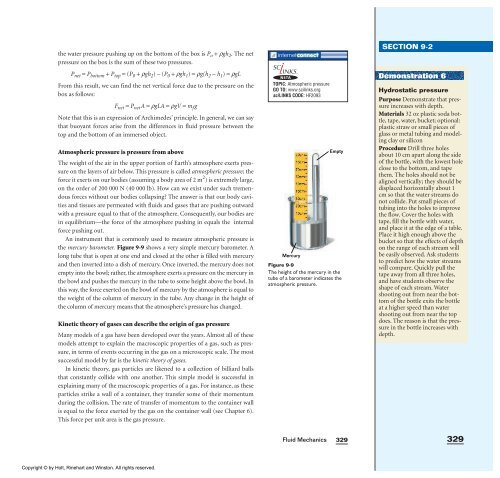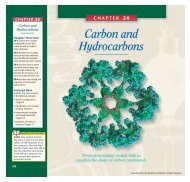Create successful ePaper yourself
Turn your PDF publications into a flip-book with our unique Google optimized e-Paper software.
the water pressure pushing up on the bottom of the box is P o + rgh 2. The net<br />
pressure on the box is the sum of these two pressures.<br />
P net = P bottom + P top = (P 0 + rgh 2) – (P 0 + rgh 1) = rg(h 2 − h 1) = rgL<br />
From this result, we can find the net vertical force due to the pressure on the<br />
box as follows:<br />
F net = P netA = rgLA = rgV = m fg<br />
Note that this is an expression of Archimedes’ principle. In general, we can say<br />
that buoyant forces arise from the differences in fluid pressure between the<br />
top and the bottom of an immersed object.<br />
Atmospheric pressure is pressure from above<br />
The weight of the air in the upper portion of Earth’s atmosphere exerts pressure<br />
on the layers of air below. This pressure is called atmospheric pressure; the<br />
force it exerts on our bodies (assuming a body area of 2 m 2 ) is extremely large,<br />
on the order of 200 000 N (40 000 lb). How can we exist under such tremendous<br />
forces <strong>with</strong>out our bodies collapsing? The answer is that our body cavities<br />
and tissues are permeated <strong>with</strong> fluids and gases that are pushing outward<br />
<strong>with</strong> a pressure equal to that of the atmosphere. Consequently, our bodies are<br />
in equilibrium—the force of the atmosphere pushing in equals the internal<br />
force pushing out.<br />
An instrument that is commonly used to measure atmospheric pressure is<br />
the mercury barometer. Figure 9-9 shows a very simple mercury barometer. A<br />
long tube that is open at one end and closed at the other is filled <strong>with</strong> mercury<br />
and then inverted into a dish of mercury. Once inverted, the mercury does not<br />
empty into the bowl; rather, the atmosphere exerts a pressure on the mercury in<br />
the bowl and pushes the mercury in the tube to some height above the bowl. In<br />
this way, the force exerted on the bowl of mercury by the atmosphere is equal to<br />
the weight of the column of mercury in the tube. Any change in the height of<br />
the column of mercury means that the atmosphere’s pressure has changed.<br />
Kinetic theory of gases can describe the origin of gas pressure<br />
Many models of a gas have been developed over the years. Almost all of these<br />
models attempt to explain the macroscopic properties of a gas, such as pressure,<br />
in terms of events occurring in the gas on a microscopic scale. The most<br />
successful model by far is the kinetic theory of gases.<br />
In kinetic theory, gas particles are likened to a collection of billiard balls<br />
that constantly collide <strong>with</strong> one another. This simple model is successful in<br />
explaining many of the macroscopic properties of a gas. For instance, as these<br />
particles strike a wall of a container, they transfer some of their momentum<br />
during the collision. The rate of transfer of momentum to the container wall<br />
is equal to the force exerted by the gas on the container wall (see Chapter 6).<br />
This force per unit area is the gas pressure.<br />
Copyright © by Holt, Rinehart and Winston. All rights reserved.<br />
NSTA<br />
TOPIC: Atmospheric pressure<br />
GO TO: www.scilinks.org<br />
sciLINKS CODE: HF2093<br />
Mercury<br />
<strong>Fluid</strong> <strong>Mechanics</strong><br />
Empty<br />
Figure 9-9<br />
The height of the mercury in the<br />
tube of a barometer indicates the<br />
atmospheric pressure.<br />
329<br />
SECTION 9-2<br />
Demonstration 6<br />
Hydrostatic pressure<br />
Purpose Demonstrate that pressure<br />
increases <strong>with</strong> depth.<br />
Materials 32 oz plastic soda bottle,<br />
tape, water, bucket; optional:<br />
plastic straw or small pieces of<br />
glass or metal tubing and modeling<br />
clay or silicon<br />
Procedure Drill three holes<br />
about 10 cm apart along the side<br />
of the bottle, <strong>with</strong> the lowest hole<br />
close to the bottom, and tape<br />
them. The holes should not be<br />
aligned vertically; they should be<br />
displaced horizontally about 1<br />
cm so that the water streams do<br />
not collide. Put small pieces of<br />
tubing into the holes to improve<br />
the flow. Cover the holes <strong>with</strong><br />
tape, fill the bottle <strong>with</strong> water,<br />
and place it at the edge of a table.<br />
Place it high enough above the<br />
bucket so that the effects of depth<br />
on the range of each stream will<br />
be easily observed. Ask students<br />
to predict how the water streams<br />
will compare. Quickly pull the<br />
tape away from all three holes,<br />
and have students observe the<br />
shape of each stream. Water<br />
shooting out from near the bottom<br />
of the bottle exits the bottle<br />
at a higher speed than water<br />
shooting out from near the top<br />
does. The reason is that the pressure<br />
in the bottle increases <strong>with</strong><br />
depth.<br />
329
















